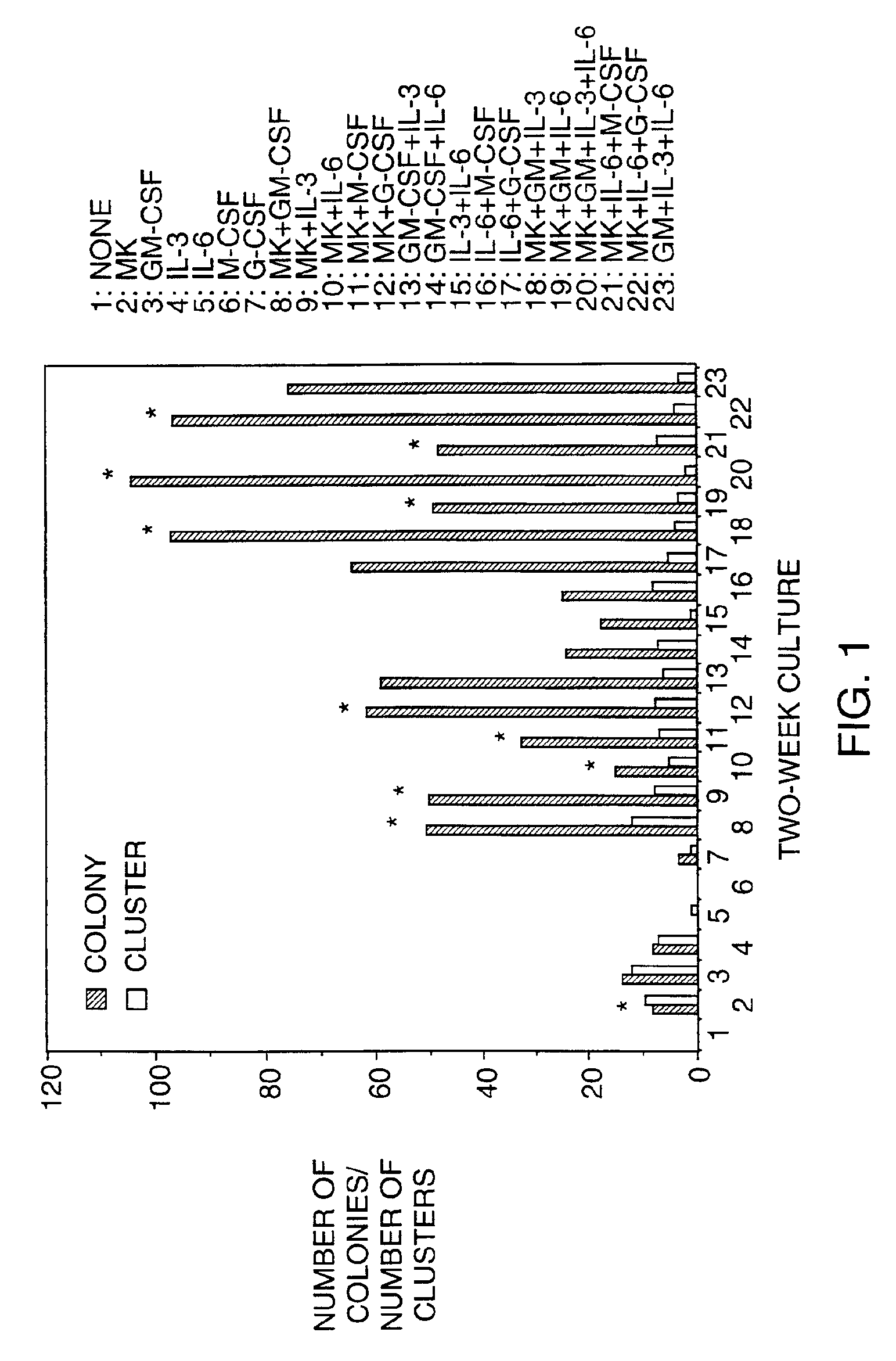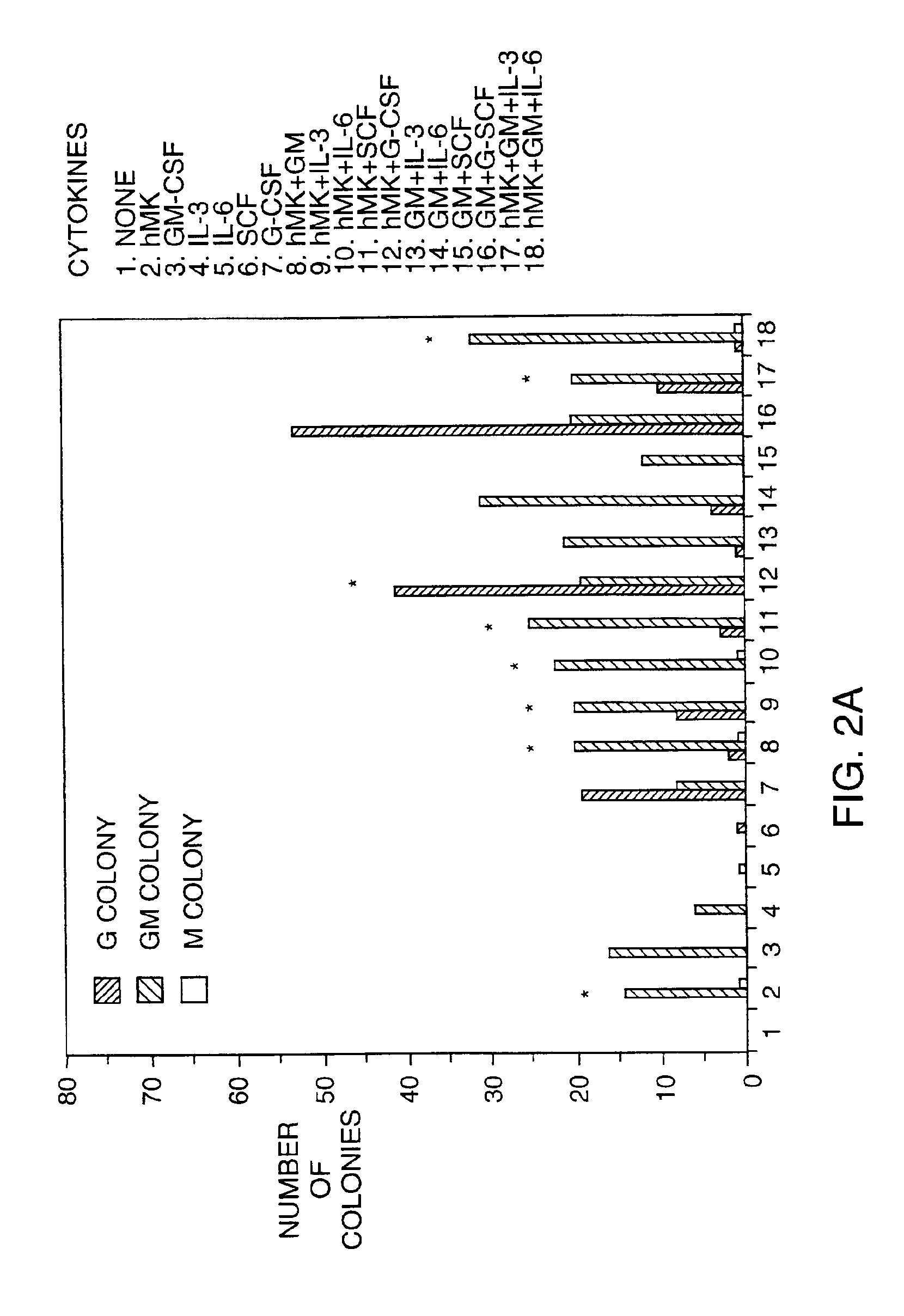Expansion of hematopoietic cells using midkine or pleiotrophin
- Summary
- Abstract
- Description
- Claims
- Application Information
AI Technical Summary
Benefits of technology
Problems solved by technology
Method used
Image
Examples
example 1
Effect of MK on Promoting Neutrophil Recovery in a Neutropenia Model.
[0049]Neutropenia is a disease wherein neutrophils that play the most important role in preventing infection are selectively lost or significantly reduced in member. In the following is presented an example, wherein MK was administered in a neutropenia model prepared by administering an antitumor drug to normal mice and examined for its effect on promoting neutrophil recovery.
[0050]Neutropenia model mice were prepared by administering an antitumor drug, Cyclophosphamide (CY) to 12-week-old ICR mice (male). The mice were divided into the following groups so that each group had five mice; (1) untreated group (control group), (2) CY-administered group, (3) CY+MK-administered group, and (4) MK alone administered group. MK was diluted with physiological saline and intraperitoneally administered to the mice daily at a dose of 0.1 ml / animal and 300 μg / kg for 13 consecutive days. Six house after the administration on the 5...
example 2
Colony Formation Promoting Action of MK and Other Cytokines on Human Peripheral Blood Mononuclear Cells
[0051]For collecting human peripheral blood stem cells (PBSC), it is necessary to let them migrate from the bone marrow to the peripheral blood. A hematopoietic factor, G-CSF, was administered to an individual, who was in a hematologically stable condition, to induce migration of PBSC to the peripheral blood, and the blood was collected with a heparinized syringe. The peripheral blood was fractionated using a separation agent. The mononuclear cell layer thus fractionated was mixed with phosphate buffer (PBS), and centrifuged at 4° C. and 1500 rpm for 5 min. After the centrifugation, the supernatant was discarded and cells were washed by repeating this procedure several times. The cells were suspended in a medium containing 10% FBS and counted with a hemocytometer K-8000. Finally, the cell concentration was adjusted to 1×106 / ml with a medium containing 10% FBS.
[0052]Test substances ...
example 3
Liquid Culture of Human Peripheral Blood Mononuclear Cells in the Presence of MK and Other Cytokines
[0056]Human peripheral blood mononuclear cells and test substances were prepared as in Example 2. The test substances were respectively added to the mixture containing 1.5×105 / ml of cells, 30% of FBS, and 10% of the medium containing 10% BSA to give the above-described concentrations. The resulting mixture was distributed onto a plastic culture dish (Falcon, 1008) and cultured in a 5% carbon dioxide incubator at 100% humidity and 37° C. for 2 weeks.
[0057]After 2 weeks, all cells were recovered from each culture dish. Cells adhering to the culture dish were recovered by treating them with 0.25 trypsin / EDTA. Cells were recovered in tubes and centrifuged once at 4° C. and 800 rpm. The cells were suspended in the same volume of the culture medium and counted with a hemocytometer.
[0058]The cells collected for counting were mounted onto a slide glass with a Cytospin (Cytospin 2; SHANDON) an...
PUM
 Login to View More
Login to View More Abstract
Description
Claims
Application Information
 Login to View More
Login to View More - R&D
- Intellectual Property
- Life Sciences
- Materials
- Tech Scout
- Unparalleled Data Quality
- Higher Quality Content
- 60% Fewer Hallucinations
Browse by: Latest US Patents, China's latest patents, Technical Efficacy Thesaurus, Application Domain, Technology Topic, Popular Technical Reports.
© 2025 PatSnap. All rights reserved.Legal|Privacy policy|Modern Slavery Act Transparency Statement|Sitemap|About US| Contact US: help@patsnap.com



